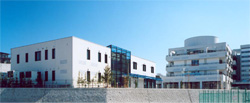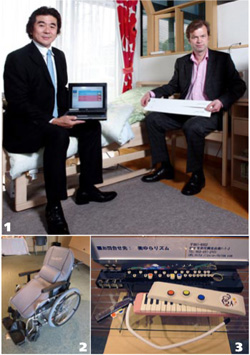Home > Highlighting JAPAN > Highlighting Japan JUNE 2012 > Sendai City-Finland Wellbeing
Highlighting JAPAN
COVER STORY: Life Innovation for the World
Sendai City-Finland Wellbeing
Progress is also being made in life innovation initiatives carried out in conjunction with other countries. At the Sendai-Finland Wellbeing Center (S-FWBC) in Miyagi Prefecture, a joint project between Sendai City and the government of Finland, research and development into the ideal services and equipment for the elderly is being conducted through collaboration between industry, academia and the government. The Japan Journal's Ames Pomeroy spoke with Dr. Juha Teperi, the director of the R&D Unit in the Center.

R&D Unit (left) and a special nursing home of the Sendai-Finland Wellbeing Center
Credit: COURTESY OF SENDAI-FINDALAND WELLBEING CENTER
How did the cooperative relationship between Sendai City and Finland for this project come about?
Dr. Juha Teperi: In 1997, the then Finnish president and Japanese prime minister engaged in talks and reached an agreement that the two countries should somehow work in concert to address the large-scale and rapid aging of society that both countries were facing. Then, through discussions between the Japanese and Finnish governments, Sendai city was selected from among several candidate sites as the project hub, and the center was established in 2005.
One of the reasons Sendai was chosen was for its many prestigious universities and research institutions, Tohoku University, Tohoku University Hospital and Tohoku Fukushi University among them. For its part, Finland regards these institutions as the business foundations that will generate profits. In addition, Sendai is also a comfortable place to live year round and being blessed with nature, is a region that shares a similar climate and environment to Finland. Those factors are also important in the development of products and services.

Products developed in the Sendai-Finland Wellbeing Center
1. Dr. Juha Teperi (right) with President Hidemasa Nishii of Sendai's Kohshin Rubber. Working in conjunction with Finnish businesses, Kohshin Rubber developed a product that monitors elderly people's safe sleep through the placement of sensors under bed mattresses. Dr. Teperi holds one of the sensors, while President Nishii holds a monitor that indicates the sleep state of the person sleeping in the bed. Shot at the exhibition facility of the R&D Unit, the Sendai-Finland Wellbeing Center.
2. "Sukedachi For You" is a wheelchair with a function that helps the user to stand.
3. "Yurarizumu" is a musical instrument useful in rehabilitation.
Credit: COURTESY OF SENDAI-FINDALAND WELLBEING CENTER
Please tell us about the facilities at the Sendai-Finland Wellbeing Center.
The center has an R&D Unit. Its tenants include a variety of Japanese and Finnish universities, small-to-medium sized businesses and NPOs engaged in research and development. Also, adjacent to the R&D Unit is a special nursing home. Opened in 2004, the nursing home is equipped with 120 beds and services between forty and fifty outpatient visitors each day. The R&D Unit and the nursing home have a cooperative relationship. Equipment developed in the R&D Unit is used in the nursing home, and surveys are also conducted on the actual usability of the equipment.
What kinds of products have been put to practical use due to the research and development carried out at the Sendai-Finland Wellbeing Center?
To date, the products jointly produced at the center by Japanese and Finnish businesses and universities have been sold in Japan and Europe. One such example is computer database software for after dental surgery. After extensive dental surgery, various changes manifest not only in one's expression but also in the movement of the jaw and mouth. The database software is used to simulate such changes before surgery takes place. This has made it possible to select the method of surgery with the least impact based on the simulation.
The center not only develops health and welfare-related products but services as well. An example of this is the popularization of "Nordic Walking." Think of Nordic Walking as a kind of walking that only uses the stocks (ski poles), without putting on the skis themselves. The sport originated in Finland and is very beneficial to health. Even for the elderly, Nordic Walking is effective in improving basic physical fitness and the motivation to exercise. The center is working to popularize Nordic Walking in conjunction with Tohoku Fukushi University and Sendai City. In 2007, the Japan Nordic Fitness Association was established in the R&D Unit, and today the association has spread to around a hundred corporate members across Japan.
Is the center working on anything looking towards the future?
While the center is currently in the third year of the second Five-year Agreement, there are still many things we can provide as a center. Looking ahead, we hope to pursue development in areas such as "social robots," which use sensors and cameras to respond to people's language and movements to help comfort the elderly, and "learning therapy" which uses game software to help treat dementia.© 2009 Cabinet Office, Government of Japan






